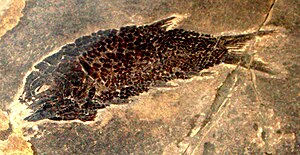Halecomorphi
| Halecomorphi | ||||||||||||
|---|---|---|---|---|---|---|---|---|---|---|---|---|

Eoeugnathus megalepis , a representative of the Halecomorphi from the middle Triassic of the Alps. |
||||||||||||
| Temporal occurrence | ||||||||||||
| Middle Triassic ( Anisium ) until today | ||||||||||||
| 240 to 0 million years | ||||||||||||
| Locations | ||||||||||||
|
||||||||||||
| Systematics | ||||||||||||
|
||||||||||||
| Scientific name | ||||||||||||
| Halecomorphi | ||||||||||||
| Cope , 1872 | ||||||||||||
The Halecomorphi are a taxon of the Neuflosser (Neopterygii). It includes the recent bald pike ( Amia calva ) and its closer fossil relatives ( Amiidae , Caturidae , Liodesmidae , Sinamiidae , Ionoscopiformes , Parasemionotiformes ). The Halecomorphi are characterized on the one hand by original features, such as mostly strongly mineralized scales, but also by "modern" features, particularly in the structure of the skull (e.g. position and shape of the preopercular ).
There are two competing hypotheses for the systematic position of the Halecomorphi:
- The Halecostomi hypothesis sees them as a sister group of the real bony fish (Teleostei).
- The Holostei hypothesis sees them as a sister group of the bone pike (Lepisosteidae) and their closer fossil relatives, which together operate under the name Ginglymodi .
literature
- Brian J. Gardiner, John G. Maisey, D. Tim J. Littlewood: Interrelationships of Basal Neopterygians. Pp. 117–146 in: Melanie LJ Stiassny, Lynne R. Parenti, G. David Johnson (Eds.): Interrelationships of Fishes. Academic Press, 1996, ISBN 0-12-670950-5
- Lance Grande, William E. Bemis: A Comprehensive Phylogenetic Study of Amiid Fishes (Amiidae) Based on Comparative Skeletal Anatomy. An Empirical Search for Interconnected Patterns of Natural History. Society of Vertebrate Paleontology Memoir. Vol. 4 (Supplementum to the Journal of Vertebrate Paleontology Vol. 18), 1998, 696 S., doi : 10.1080 / 02724634.1998.10011114
Web links
- Palaeos: Halecomorphi